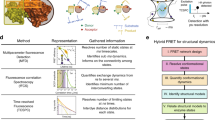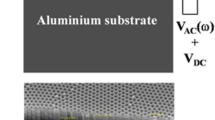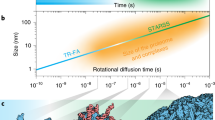Abstract
Biomolecular dynamics and stability are predominantly investigated in vitro and extrapolated to explain function in the living cell. We present fast relaxation imaging (FreI), which combines fluorescence microscopy and temperature jumps to probe biomolecular dynamics and stability inside a single living cell with high spatiotemporal resolution. We demonstrated the method by measuring the reversible fast folding kinetics as well as folding thermodynamics of a fluorescence resonance energy transfer (FRET) probe-labeled phosphoglycerate kinase construct in two human cell lines. Comparison with in vitro experiments at 23–49 °C showed that the cell environment influences protein stability and folding rate. FReI should also be applicable to the study of protein-protein interactions and heat-shock responses as well as to comparative studies of cell populations or whole organisms.
This is a preview of subscription content, access via your institution
Access options
Subscribe to this journal
Receive 12 print issues and online access
$259.00 per year
only $21.58 per issue
Buy this article
- Purchase on Springer Link
- Instant access to full article PDF
Prices may be subject to local taxes which are calculated during checkout





Similar content being viewed by others
References
Frauenfelder, H., Sligar, S.G. & Wolynes, P.G. The energy landscapes and motions of proteins. Science 254, 1598–1603 (1991).
Cheung, M.S., Klimov, D. & Thirumalai, D. Molecular crowding enhances native state stability and refolding rates of globular proteins. Proc. Natl. Acad. Sci. USA 102, 4753–4758 (2005).
Ignatova, Z. et al. From the test tube to the cell: exploring the folding and aggregation of a beta-clam protein. Biopolymers 88, 157–163 (2007).
Frauenfelder, H., Fenimore, P.W., Chen, G. & McMahon, B.H. Protein folding is slaved to solvent motions. Proc. Natl. Acad. Sci. USA 103, 15469–15472 (2006).
Johnson, J.L. & Craig, E.A. Protein folding in vivo: unraveling complex pathways. Cell 90, 201–204 (1997).
Hartl, F.U. & Hayer-Hartl, M. Converging concepts of protein folding in vitro and in vivo. Nat. Struct. Mol. Biol. 16, 574–581 (2009).
Evans, C.L. & Xie, X.S. Coherent anti-Stokes Raman scattering microscopy: chemical imaging for biology and medicine. Annu. Rev. Anal. Chem. 1, 883–909 (2008).
Ignatova, Z. & Gierasch, L.M. Monitoring protein stability and aggregation in vivo by real-time fluorescent labeling. Proc. Natl. Acad. Sci. USA 101, 523–528 (2004).
Kural, C. et al. Kinesin and dynein move a peroxisome in vivo: a tug-of-war or coordinated movement? Science 308, 1469–1472 (2005).
Luby-Phelps, K., Castle, P.E., Taylor, D.L. & Lanni, F. Hindered diffusion of inert tracer particles in the cytoplasm of mouse 3t3 cells. Proc. Natl. Acad. Sci. USA 84, 4910–4913 (1987).
Lippincott-Schwartz, J., Snapp, E. & Kenworthy, A. Studying protein dynamics in living cells. Nat. Rev. Mol. Cell Biol. 2, 444–456 (2001).
Williams, S.P., Haggie, P.M. & Brindle, K.M. F-19 NMR measurements of the rotational mobility of proteins in vivo. Biophys. J. 72, 490–498 (1997).
Serber, Z. et al. High-resolution macromolecular NMR spectroscopy inside living cells. J. Am. Chem. Soc. 123, 2446–2447 (2001).
Inomata, K. et al. High-resolution multi-dimensional NMR spectroscopy of proteins in human cells. Nature 458, 106–109 (2009).
Gruebele, M. Fast protein folding kinetics. in Protein Folding, Misfolding and Aggregation (ed. Muñoz, V.) 106–138 (RSC Publishing, London, 2008).
Ma, H.R., Wan, C.Z. & Zewail, A.H. Ultrafast T-jump in water: studies of conformation and reaction dynamics at the thermal limit. J. Am. Chem. Soc. 128, 6338–6340 (2006).
Clarke, P.G.H. Developmental cell-death—morphological diversity and multiple mechanisms. Anat. Embryol. (Berl.) 181, 195–213 (1990).
Yu, J., Xiao, J., Ren, X.J., Lao, K.Q. & Xie, X.S. Probing gene expression in live cells, one protein molecule at a time. Science 311, 1600–1603 (2006).
Brandenburg, B. et al. Imaging poliovirus entry in live cells. PLoS Biol. 5, 1543–1555 (2007).
Mattheyses, A.L., Shaw, K. & Axelrod, D. Effective elimination of laser interference fringing in fluorescence microscopy by spinning azimuthal incidence angle. Microsc. Res. Tech. 69, 642–647 (2006).
Dingel, B. & Kawata, S. Speckle-free image in a laser-diode microscope by using the optical feedback effect. Opt. Lett. 18, 549–551 (1993).
Osvath, S., Sabelko, J.J. & Gruebele, M. Tuning the heterogeneous early folding dynamics of phosphoglycerate kinase. J. Mol. Biol. 333, 187–199 (2003).
Kamei, Y. et al. Infrared laser-mediated gene induction in targeted single cells in vivo. Nat. Methods 6, 79–81 (2009).
Osvath, S., Herenyi, L., Zavodszky, P., Fidy, J. & Kohler, G. Hierarchic finite level energy landscape model to describe the refolding kinetics of phosphoglycerate kinase. J. Biol. Chem. 281, 24375–24380 (2006).
Wibo, M. & Poole, B. Protein degradation in cultured cells. 2. Uptake of chloroquine by rat fibroblasts and inhibition of cellular protein degradation and cathepsin-B1. J. Cell Biol. 63, 430–440 (1974).
Golding, I., Paulsson, J., Zawilski, S.M. & Cox, E.C. Real-time kinetics of gene activity in individual bacteria. Cell 123, 1025–1036 (2005).
Kar, S., Baumann, W.T., Paul, M.R. & Tyson, J.J. Exploring the roles of noise in the eukaryotic cell cycle. Proc. Natl. Acad. Sci. USA 106, 6471–6476 (2009).
Leadsham, J.E. & Gourlay, C.W. Cytoskeletal induced apoptosis in yeast. Biochim. Biophys. Acta 1783, 1406–1412 (2008).
Vieira, M.N.N., Figueroa-Villar, J.D., Meirelles, M.N.L., Ferreira, S.T. & De Felice, F.G. Small molecule inhibitors of lysozyme amyloid aggregation. Cell Biochem. Biophys. 44, 549–553 (2006).
Acknowledgements
We acknowledge funding from the US National Science Foundation (MCB 0613643). A.D. was supported by the National Science Foundation Center for Physics of Living Cells (Illinois Physics Department) while part of this work was carried out. S.E. and M.G. acknowledge support from the Alexander von Humboldt Foundation. We thank Z. Shen and K.V. Prasanth for growing the U2OS and HeLa cell lines.
Author information
Authors and Affiliations
Contributions
A.D. and S.E. designed and implemented instrumentation and software, performed experiments, analyzed data and wrote the paper. J.D.M. designed experimental components. M.G. designed the experiment, analyzed data and wrote the paper.
Corresponding author
Ethics declarations
Competing interests
The authors declare no competing financial interests.
Rights and permissions
About this article
Cite this article
Ebbinghaus, S., Dhar, A., McDonald, J. et al. Protein folding stability and dynamics imaged in a living cell. Nat Methods 7, 319–323 (2010). https://doi.org/10.1038/nmeth.1435
Received:
Accepted:
Published:
Issue Date:
DOI: https://doi.org/10.1038/nmeth.1435
This article is cited by
-
Fever as an evolutionary agent to select immune complexes interfaces
Immunogenetics (2022)
-
Single-molecule displacement mapping unveils nanoscale heterogeneities in intracellular diffusivity
Nature Methods (2020)
-
Quantifying protein dynamics and stability in a living organism
Nature Communications (2019)
-
A biosensor-based framework to measure latent proteostasis capacity
Nature Communications (2018)
-
Toward an understanding of biochemical equilibria within living cells
Biophysical Reviews (2018)



